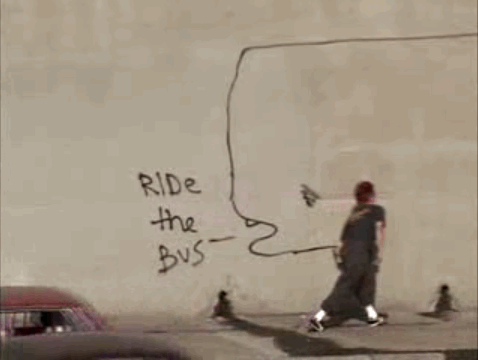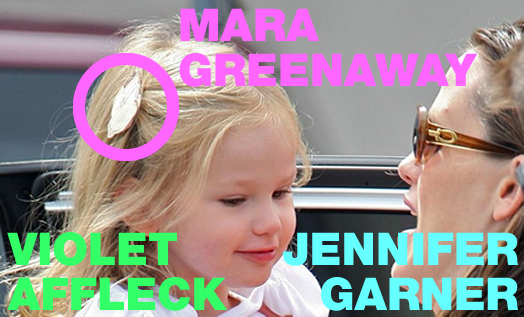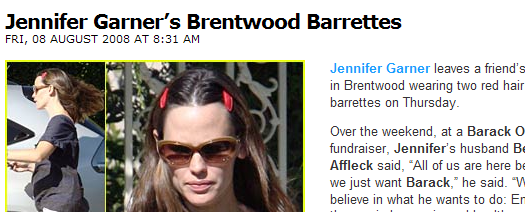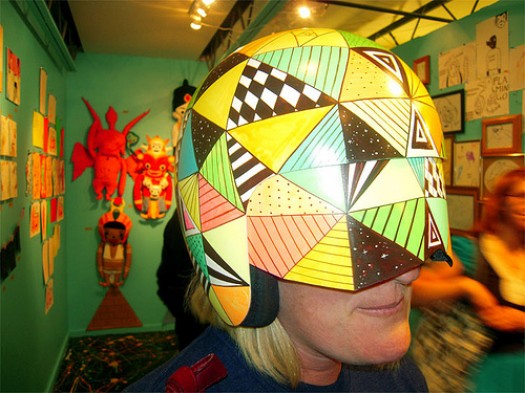The Nike Air Jordan 3 Black Cat … This shoe frightened me when it first came out in 1988. It looked like it had arrived from outer space, which made it absolutely the perfect shoe for Jordan to wear when he was just beginning to dominate the NBA. His game was threatening. These shoes were so sleek, so — it must be said — fierce, that a kid knew that he needed to step up his game in order to be worthy of them. I'm currently totally riveted by the extensive Air Jordan documentation and commentary on the web. For instance, here's a killer 8‑minute video profile of Tinker Hatfield, the genius behind the Jordan line. Nobody in the world can cover my main man, Michael Jordan … Impossible! Impossible! Impossible! Imposs-!
Category: visual
Anything that can be seen. Stuff with in this category is generally somehow interesting to look at, beautiful, stunning, provocative, silly, crrrrraaaaaazy, intriguing, or inspirational.
Dream team

Saul Steinberg's cover for the first edition The Americans by Robert Frank. Publisher Robert Delpire: "The only point of disagreement was the cover. I insisted right away on using a drawing by Saul Steinberg, whom I had met and whose work I liked. Frank said, 'It's a book of photos, we could use a photo.' I told him, 'You can use a photo for the American edition, but let me use a Steinberg drawing.' But when I reprinted the book in 1986, I used a photograph because I had discovered, basically, that he was right."
Photographer Robert Frank is known for a few things, primarily The Americans, a ground-breaking book of photography published in the late 50's. He is also known for avant-garde film-making, e.g., Pull My Daisy, and his never-released Rolling Stones documentary with an unprintable name.We checked out SFMOMA's 50th anniversary retrospective of The Americans today, and I was astonished at another of Frank's skills: Grant-writing. In order to fund the gathering of the photos that became The Americans, he applied for a Guggenheim Fellowship. I've pasted his clear, simple, two-part essay below.
Part 1: Frank's brief summary of the proposal
To photograph freely throughout the United States, using the miniature camera exclusively. The making of a broad, voluminous picture record of things American, past and present. This project is essentially the visual study of a civilization and will include caption notes; but it is only partly documentary in nature: one of its aims is more artistic than the word documentary implies.
Part 2: The full statement of intent
I am applying for a Fellowship with a very simple intention: I wish to continue, develop and widen the kind of work I already do, and have been doing for some ten years, and apply it to the American nation in general. I am submitting work that will be seen to be documentation — most broadly speaking. Work of this kind is, I believe, to be found carrying its own visual impact without much work explanation. The project I have in mind is one that will shape itself as it proceeds, and is essentially elastic. The material is there: the practice will be in the photographer's hand, the vision in his mind. One says this with some embarrassment but one cannot do less than claim vision if one is to ask for consideration. "The photographing of America" is a large order — read at all literally, the phrase would be an absurdity. What I have in mind, then, is observation and record of what one naturalized American finds to see in the United States that signifies the kind of civilization born here and spreading elsewhere. Incidentally, it is fair to assume that when an observant American travels abroad his eye will see freshly; and that the reverse may be true when a European eye looks at the United States. I speak of the things that are there, anywhere and everywhere — easily found, not easily selected and interpreted. A small catalog comes to the mind's eye: a town at night, a parking lot, a supermarket, a highway, the man who owns three cars and the man who owns none, the farmer and his children, a new house and a warped clapboard house, the dictation of taste, the dream of grandeur, advertising, neon lights, the faces of the leaders and the faces of the followers, gas tanks and postoffices and backyards. The uses of my project would be sociological, historical and aesthetic. My total production will be voluminous, as is usually the case when the photographer works with miniature film. I intend to classify and annotate my work on the spot, as I proceed. Ultimately the file I shall make should be deposited in a collection such as the one in the Library of Congress. A more immediate use I have in mind is both book and magazine publication.
Frank was awarded a fellowship, which amounted to $3,600, and he used this to travel in a long loop around the US in 1955–6. That "more immediate use" that he refers to in the final sentence turned into The Americans, a stunning document that is every bit as interesting 50 years later. The exhibition is captured in an extended version of The Americans, including contact sheets and commentary.
Dirty Hands / Arty documentaries
I'm psyched to check out Dirty Hands, a new documentary about artist David Choe. I'm usually skeptical about "street art" films, but the trailer looks pretty great, and I've heard that Choe is kind of a madman. I compare everything in this street/art vein to Video Days — which, by the way, did you know that can watch all of Video Days on Google Video? — and I'm always hoping that new stuff will somehow advance the form that Spike Jonze laid out all those years ago. Maybe this will? Maybe other stuff has? 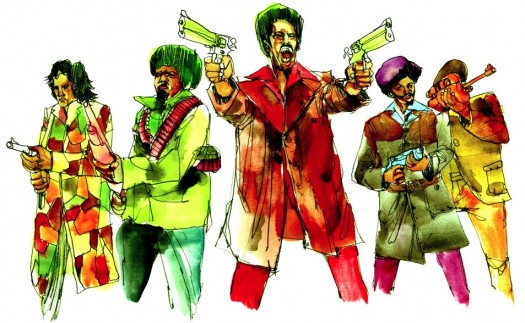 Choe worked some watercolor magic for a movie called Black Dynamite that just made some waves at Sundance.
Choe worked some watercolor magic for a movie called Black Dynamite that just made some waves at Sundance.
David Remnick's excellent biography of Muhammad Ali, King of the World contains a truly stunning scene that sprung to mind during last week's inauguration. Before Ali's first big bout, a meeting with Sonny Liston, the press didn't know what to make of Ali's confidence and bombast. A reporter asked: "Cassius, all these things you're saying about Liston, do you really mean them? Do you really think you're going to beat this guy?"
Ali: I'm Christopher Columbus … I believe I'll win. I've never been in there with him, but I believe the world is round and they all believe the world is flat. Maybe I'll fall off the world at the horizon but I believe the world is round.1
I feel like there's a thread that runs directly from this statement to last Tuesday's inauguration, and it made me want to dig deeper into Ali, the myth-maker. So last night I watched a 1964 documentary, made by photographer William Klein, called Muhammad Ali: The Greatest; it's included in a recent Criterion Collection release called The Delirious Fictions of William Klein, which is cheap‑o on Amazon right now, actually.
 Typography suits the subject. ALI. Yeah.
Typography suits the subject. ALI. Yeah. Klein is known for his still photography, and he brings a photographer's eye, and a cavalier attitude toward editing. The movie is a montage of spontaneity and action, tracing Ali's path from the build-up to his first fight with Sonny Liston to the Rumble in the Jungle with George Foreman.
Klein is known for his still photography, and he brings a photographer's eye, and a cavalier attitude toward editing. The movie is a montage of spontaneity and action, tracing Ali's path from the build-up to his first fight with Sonny Liston to the Rumble in the Jungle with George Foreman.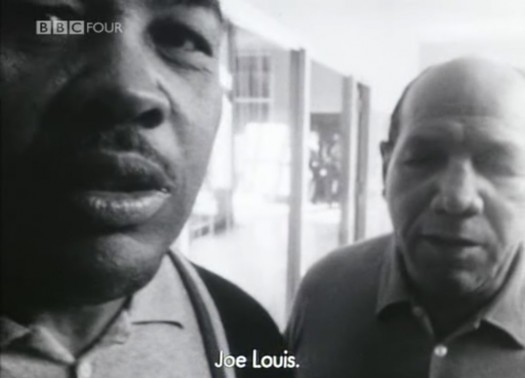 Klein catches a nice glimpse of another groundbreaking figure.
Klein catches a nice glimpse of another groundbreaking figure. Ali's second fight with Liston became infamous for the "phantom" punch that ended it. Rumors abound that Liston took a dive, either because he bet against himself or because he was afraid that the Nation of Islam would seek revenge if Ali lost. See it for yourself on the YouTubez.
Ali's second fight with Liston became infamous for the "phantom" punch that ended it. Rumors abound that Liston took a dive, either because he bet against himself or because he was afraid that the Nation of Islam would seek revenge if Ali lost. See it for yourself on the YouTubez.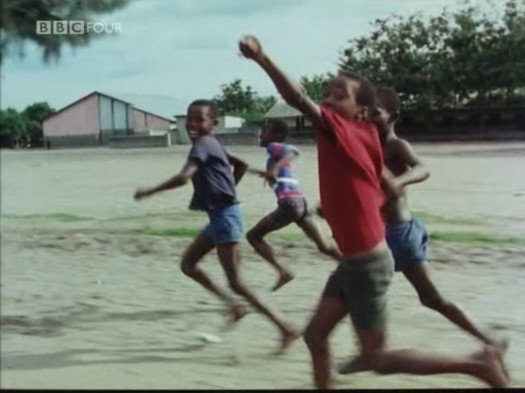 Klein captures some amazing moments around the Rumble, which took place in Zaire, 1974.
Klein captures some amazing moments around the Rumble, which took place in Zaire, 1974.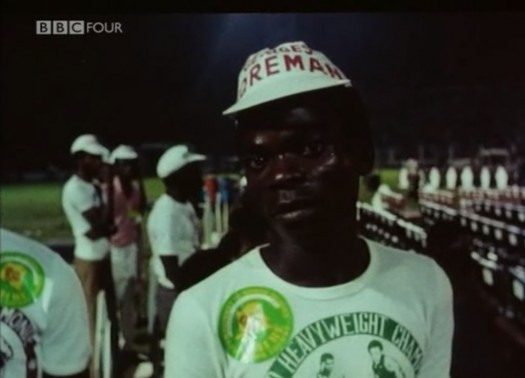 The whole nation appears to be in and around the stadium. When We Were Kings tells the whole story. It will blow your mind, and make you love Norman Mailer at the same time.
The whole nation appears to be in and around the stadium. When We Were Kings tells the whole story. It will blow your mind, and make you love Norman Mailer at the same time.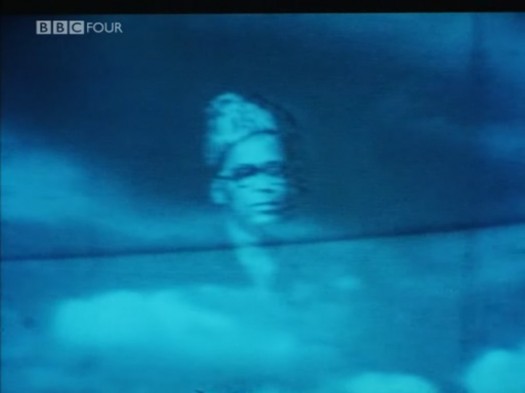 Mobutu Sese Seko, Zaire's strongman president, is omnipresent in Klein's footage from the fight. I love this image of his head slowly coming into focus from the clouds.
Mobutu Sese Seko, Zaire's strongman president, is omnipresent in Klein's footage from the fight. I love this image of his head slowly coming into focus from the clouds.Long ago, someone spray painted "US out of North Dakota" on the wall of the Cave, a little bar in the basement of a Carleton dorm. It was directly above the stage, a stage where I saw a lot of good bands (Walt Mink, FIREHOSE, Phish, and probably others). So I spent a lot of time staring at it. It made a deep impression on me. I still think about it. Which reminds me: Secession. The counties of Northern California and Southern Oregon tried to secede from their respective states in the 40's. True story. So anyway, it makes me really happy that Justin took this photo of a Duster in his neighborhood in Berkeley. Dissent! It's your patriotic duty.
The classiest fam in Hollywood loves Mara's barrettes; this time Violet rocks them. Nice. Buy em here, and pass it on.
File this one under: Holy crap. It has come to the attention of the tabloid-reading world that Jennifer Garner was seen wearing red barrettes! But, wait, there's more. A certain barrette-making friend of ours made them. By hand. In San Francisco.
This is from Just Jared, and I must say: If the blog really is just a guy named Jared writing about celebrities, my hat is off to him. He publishes some tidbit of celebrity gossip roughly every 5 seconds. That's dedication, homes. If you're interested in the barrettes, you can buy a pair for yourself at Little Something; if you're concerned that they'll make you look like Jennifer Garner, you can ask Mara for some guidance in the proper way to wear them.

I'm glad that the barrettes got the full paparazzi treatment. A couple of photos just wouldn't have been sufficient. Better get 17 and be safe. Check em all out.(Congratulations, you big loser).
I could use one of these right about now. Via these geniuses.
RFK funeral train / A breaking up
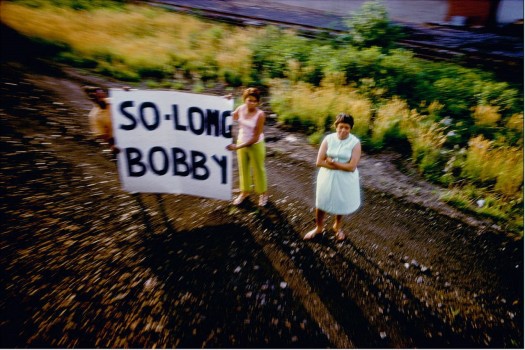
The New York Times recently ran some photos that were taken from the train carrying Bobby Kennedy's body between Washington to New York. The photos themselves are amazing documents of a nation in mourning, people from all walks of life lining the tracks, holding signs, saluting or just watching, but they're also beautiful — saturated and blurred, creating the sensation that things are moving too fast, that something is irresistibly barreling on. The photographer, Paul Fusco, narrates a slideshow on the New York Times site, and it's well worth a viewing. He's nicely describes the experience around the photos, and provides some insight into the mechanics (Kodachrome film, of course). He also mentions that he hadn't planned on taking pictures while on the train; he was simply traveling along with the coffin to take photos at the funeral.
The first thing I saw were hundreds of people on the platform … Fortunately, I just reacted. My instinct was: There's something going on, photograph it … [The train] was a moving platform. I couldn't change my view. I couldn't change my perspective. I had to just … grab it, when I could.
 "Everyone was there. America came out to mourn." Photos: Paul Fusco/Magnum Photos
"Everyone was there. America came out to mourn." Photos: Paul Fusco/Magnum PhotosFusco has a show that's currently at Danziger Project in New York, and a book coming out in the fall, too. Looks nice.

